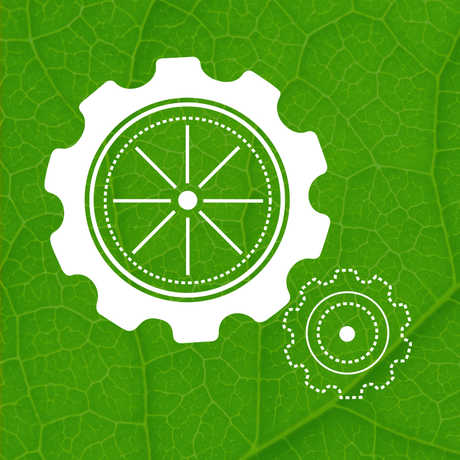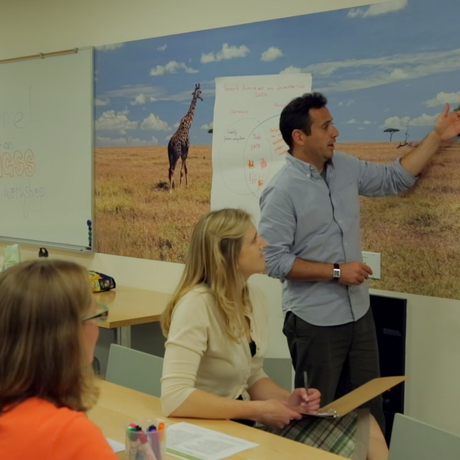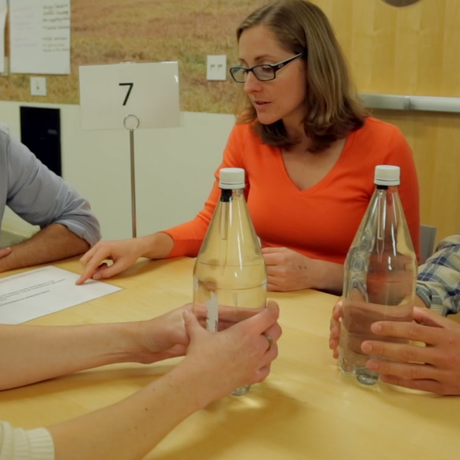
The Practices Brainstorm and Sort introduces the Science and Engineering Practices and helps educators connect their prior knowledge about science and engineering to this new conceptual framework. Participants will work together to sort their own words into the eight practices, filling posters to form a collective definition of each practice. Whole-group discussions will pull out key ideas about the practices as a concept and about particular practices.
Watch the video above to get an overview, and use the detailed lesson plan below to lead this professional development activity for your team of educators.
Learning Goals
Participants in the activity will
- become familiar with the titles of the eight Science and Engineering Practices (SEPs)
- know that the practices are the tools and techniques that scientist and engineers use.
- begin to build definitions of the eight SEPs.
- discover that the SEPs are not new or foreign ideas; rather, they map onto what we already know about the process of science and provide a consistent framework for talking about doing science.
Approximate Time
35 minutes
Materials
- large easel paper/chart paper
- 1 blank poster per group
- 8 posters with headings of the 8 SEPs
- 1 poster with the heading “Missing”
- post-its (1-2 stacks for each group of 3-5 people)
- Practices sorting sheets (1 set per group)
- (Optional) Appendix F from the NGSS
- (Optional) SEP List Handout
Prepare
- Print the practices sorting sheets. Laminate or print on cardstock for ease of use in sorting post-its.
- Prepare sorting posters: eight titled with one practice each, and one titled “Missing.”
- Print SEP List handout, or write a list of the eight practices on a whiteboard or poster, to reveal at the beginning of Part 2.
- Alternate version: Make sure that each group has enough post-its of the same three colors.
Background for Facilitators
The eight Science and Engineering Practices (SEPs) are the tools and techniques that scientists and engineers use, and make up one of the three “dimensions” of the Next Generation Science Standards (NGSS). The SEPs are a good entry point into understanding the NGSS, and a good place for teachers to begin bringing the NGSS into their classrooms, since they can be used with students to explore any content.
The Practices Brainstorm and Sort serves as an introduction to the SEPs as a way to organize ideas about what scientists and engineers do. Participants will have time to think independently about what they already understand about science and engineering, as well as time to collaborate with fellow educators to fit their prior knowledge into this new framework. Groups will do this by sorting their own words into the eight practices, filling each poster with verbs to form a collective definition for each of the SEPs. Whole-group discussions will help to pull out key ideas about the SEPs as a concept and about particular practices.
It’s usually easy for participants to come up with words during their brainstorm and to ultimately fill the posters. It’s useful to point this out, as it’s evidence that we all have some (or many!) ideas about what science and engineering look like, and are simply being asked to organize this knowledge around this new SEP framework.
Please note that this activity is just an introduction to the practices, and should be followed up with more activities (see related activities Science and Engineering Practices Circus and Comparing the Science and Engineering Practices), or by reading Appendix F of the NGSS, which describes each practice in depth.
Activity
Part 1: Brainstorm and Gallery Walk (10 minutes)
- Open with the question “what do scientists and engineers do?” Give participants two minutes to silently jot down verbs to describe things that scientists and engineers do.
- Next, have participants work in groups (3 – 5 people per group) to combine their lists. Give each group a batch of post-its and one blank piece of chart paper. Tell them to write one verb per post-it and place the post-its on the chart paper.
- Display the posters and do a quick gallery walk (perhaps introduce it as a “gallery speed-walk” to keep things moving). Participants should notice words that show up on multiple posters, words that are surprising or unexpected, and any other patterns or observations.
- Lead a short discussion with the whole group. Discussion questions could include:
- Are there words that show up a lot? What are they?
- Were there words on other posters that you didn’t think of? Anything surprising?
- What else do you notice?
- Was it easy to fill up these posters? Was it hard?
Part 2: Practices Sort (15 minutes)
- Introduce the eight SEPs and give participants a moment to familiarize themselves with the titles.
- Tell participants that their next task is to sort their science verbs into these eight categories. Acknowledge that they are basing their decisions on first impressions of the titles only, and tell them not to worry about the exact definitions at this stage.
- Hand out a set of practices sorting sheets to each group. They should retrieve their post-its from their poster and sort them at their tables using the sorting sheets. In addition to the eight practices, there is a ninth category called “Missing” where they can place any post-its that they feel do not fit into the practices.
- While they are sorting at their tables, hang up the eight posters with the titles of the SEPs and the ninth poster with the title “Missing.” As groups finish sorting, have them transfer their post-its from the sorting sheets to these posters.
- After all the post-its have been added to the posters, do another “gallery speed-walk” to observe the results.
Part 3: Discussion (5-10 minutes)
- Lead another discussion with the whole group. Start by asking what it was like to sort their verbs into the SEP categories. Was it easy? Was it hard? Did they encounter any challenges?
- After this initial debrief, discuss their observations about how the words were sorted. Discussion questions may include:
- Were there any words that were sorted into different categories by different groups, or that you felt could belong in different categories? What words? Why do you think this is?
- This is a good place to point out that the practices are closely interrelated. In the real world none of the practices truly operate in isolation—because they are so closely connected, there are some skills or ideas that may overlap across multiple practices.
- What words ended up on the “missing” poster? Any ideas about these words?
- We often find that when we read out the post-its that were placed on the missing poster, other groups will have ideas about how these words might fit in with the practices after all.
- Which posters have the most words on them? Why do you think that is?
- This will vary from group to group. Planning and Carrying Out Investigations is often on the high end, but other categories may also be well populated.
- Which posters have the fewest words? Why do you think that is?
- This can also be an opportunity to discuss how practices are interrelated. Often the practice with the fewest words is “Using Mathematics and Computational Thinking.” Some people interpret this as indicating that many science teachers are uncomfortable with math and therefore didn’t think of many math-related words, while others might point out that math is hard to separate out as an independent concept, but is an implicit part of many of the other practices (such as Analyzing and Interpreting Data).
- Any other observations or thoughts?
- Were there any words that were sorted into different categories by different groups, or that you felt could belong in different categories? What words? Why do you think this is?
Make sure participants leave the discussion with these key messages:
- You already know a lot about what scientists and engineers do!
- The SEPs are not new or foreign ideas; rather, they give consistent language to the familiar processes of science.
Next steps
- If you are doing this activity by itself, end by introducing Appendix F of the NGSS (particularly the progression table at the back of the appendix). After beginning to construct their own definitions of the SEPs, participants can check out more detail about what the practices truly look like in the NGSS.
- This activity leads nicely into the Science and Engineering Practices Circus and/or Comparing the Science and Engineering Practices activities. If you will be doing either of these, wait to introduce Appendix F until after completing them.
Alternate Version
- In Part 1, introduce these three questions for the initial brainstorm: “What do scientists do? What do engineers do? What do they both do?”
- Have participants write their ideas on color-coded post-its: one color for things scientists do, a different color for things engineers do, and a third color for things they both do.
- The rest of the activity procedure remains the same.
- This modification gives the discussion a slightly different slant:
- After the first gallery walk in Part 1, add a discussion question asking participants what they notice about the color-coded post-its.
- We often see some groups designate most of their ideas as things that both scientists and engineers do, while other groups make more of a distinction, which generates an interesting conversation.
- During the discussion in Part 3, add a question asking participants to reflect on the different colors that show up on different SEP posters.
- Most posters will likely have a mix, but you might end up with science being more represented on some posters and engineering more on others. If this happens, talk about our perceptions of these skills and why they could be biased. Point out that both scientists and engineers do all of these things, just in different ways or to reach different goals.
- After the first gallery walk in Part 1, add a discussion question asking participants what they notice about the color-coded post-its.

NGSS Demystified
This training toolkit will prepare you to lead PD for other educators.
Browse all of the videos at once.

